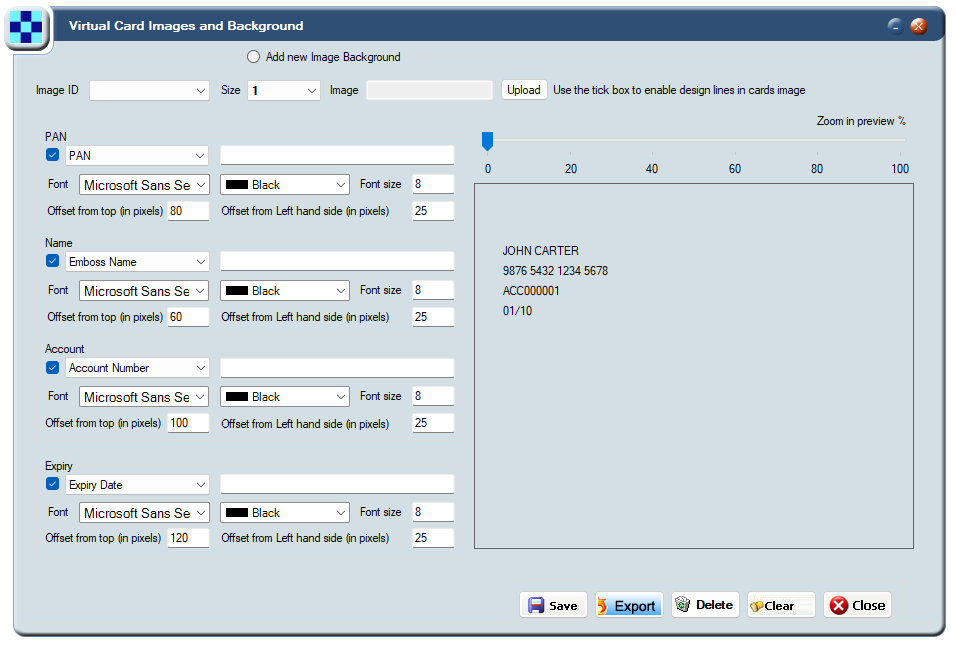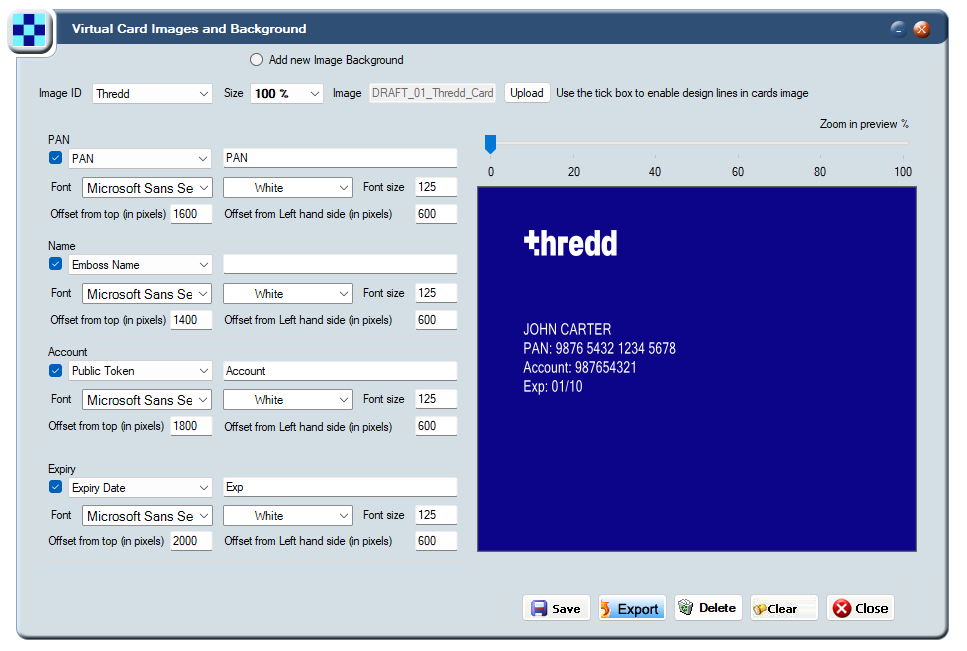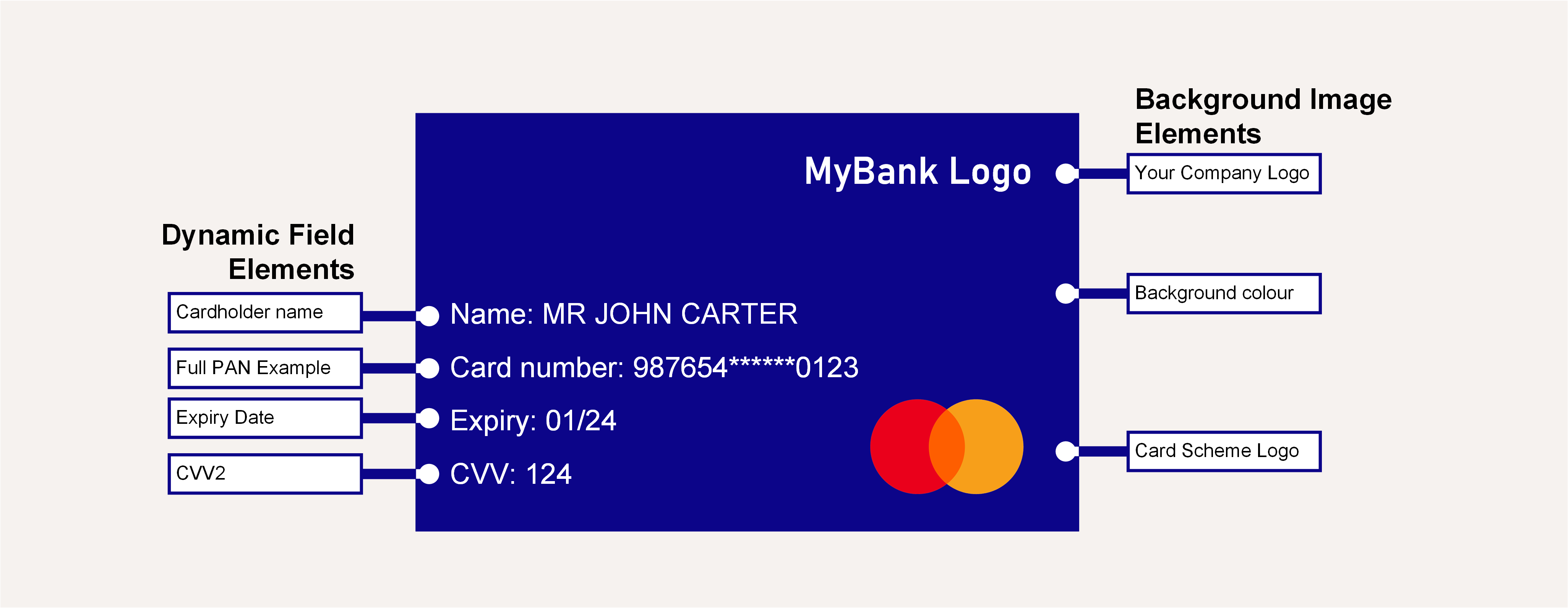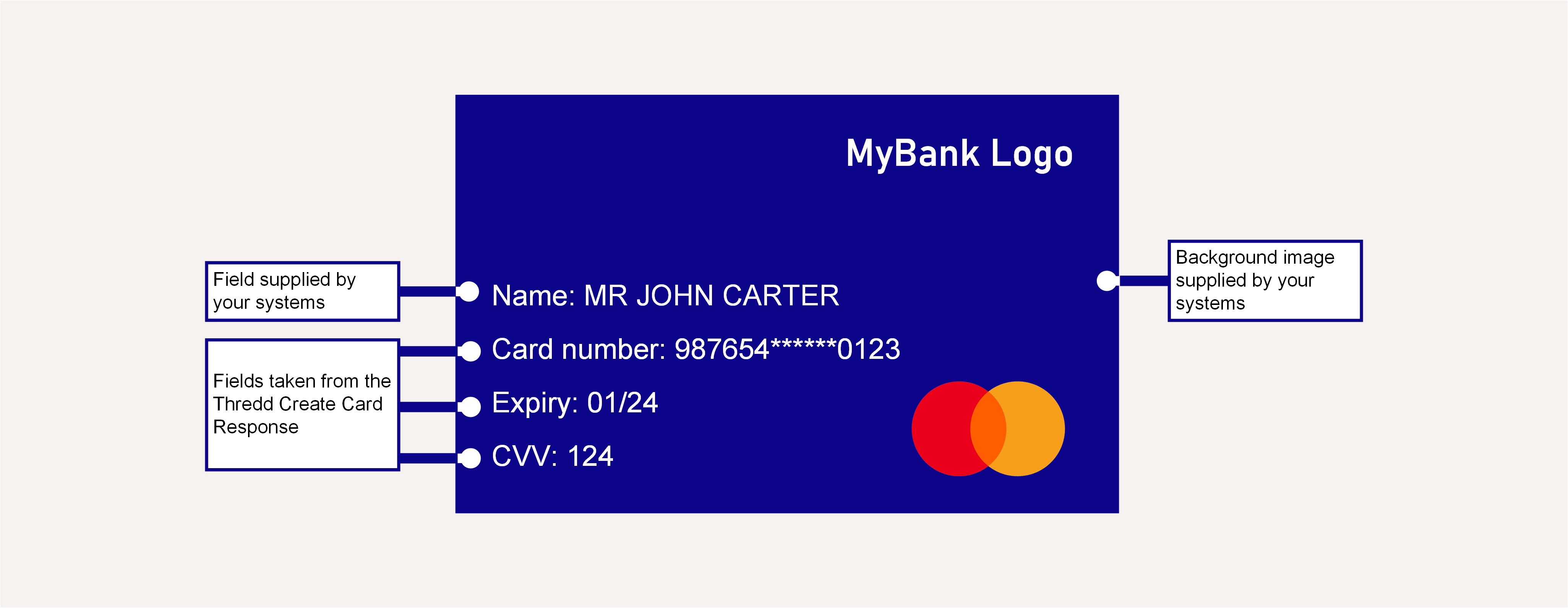5 Virtual Card Image Design
This section describes how to configure the design of your virtual card images. Three options are available:
-
Thredd generates the virtual card image: Using the Default Thredd Image Design
-
Thredd generates the virtual card image: Using a Customised Image Design
-
You use the information returned in the response to a card create requestion to Generating your Own Virtual Card Image and display it in your Customer smartphone application or on your Customer Portal.
Each of these steps is described in further detail below.
5.1 Using the Default Thredd Image Design
If you are using the Thredd system to generate a virtual card image and do not specify your own design, the default Thredd background image and dynamic field settings are used, as shown in the figure below:

Figure 2: Virtual Card Image Setup in Smart Client
The default settings for the Thredd image cannot be changed.
5.2 Using a Customised Image Design
If you are using the Thredd system to generate a virtual card image and you want to customise the appearance of the background image and dynamic text elements, please complete the Virtual Card Image tab on your Thredd Product Setup Form (PSF). See the example below.

Figure 3: Product Setup Form - Virtual Card Image tab
5.2.1 Image Options
Refer to the table below for details of image configuration options.
|
Field |
Description |
Example |
|---|---|---|
|
Image ID |
If you want to support more than one card image file, then enter a unique image ID, to identity your virtual image. The image ID to use can then be specified when creating the virtual card using the Thredd API. See Using the Cards API.
Note: To support multiple images, you should create copies of the Virtual Card Image form and populate details for each Image you want to display. |
ABCD12345 |
|
Institution Name |
Institution name, as set up in Thredd. |
MyBank |
|
Size |
Image size to be displayed. The image displayed to the cardholder will be scaled according to this setting.
Note: You can only scale up image sizes (e.g., 200%; the maximum size is 500%) |
100% |
|
Image |
Whether to use the default Thredd image or your own image for the background image. For details of supported image formats and sizes, see Background Image Specifications. |
Own |
Dynamic Field Display Options: |
||
|
Field |
There are four default fields: PAN, Name, Account and Expiry. For each field you can configure the type of dynamic content and the text format to be displayed in each field. The dynamic field content is added as a layer on top of the background image supplied. See Background Image Examples |
|
|
Enable |
Whether to display this field on the virtual image. Options are: YES or NO. |
YES |
|
Options |
The data value to display, such as PAN, Emboss Name, CVV or Expiry Date. You can use this to tweak the field types and the order in which to display them. |
PAN |
|
Text Prefix |
Whether to include any prefix text on the field, to be shown before the dynamic field value.
Example 1: Name: John Smith (where name is the prefix and John Smith is the dynamic value)
Example 2: CVV 123 (where CVV is the prefix and 123 is the dynamic value) |
Name:
CVV: |
|
Offset from the top |
The offset of this field in pixels, from the top edge of the image. We recommend you use the suggested default offset for each field. |
100 |
|
Offset from the left-hand side |
The offset of this field in pixels, from the left edge of the image. We recommend you use the suggested default offset. |
30 |
|
Font Type |
The font type (e.g., Helvetica, Arial). We have a large number of standard Windows fonts available; please check with your Implementation Manager if you have any non-standard font requirements. We recommend you use a standard font type. |
Arial |
|
Font Colour |
The colour of the field’s font. For a white image background, you should use a dark colour, such as black or grey; for a dark image background, you should use a light font colour, such as white or cream.
You must specify the colour name and not an RGB or hex value. A wide range of colours are available. For details, please check with your Implementation Manager. |
White |
|
Font Size |
Size of the field’s font in points. We recommend you use the suggested default field sizes. |
10 |
If you are unsure of how to define any of the above parameters, please provide your Implementation Manager with an example of the card display. Thredd will set the parameters accordingly.
5.2.2 Background Image Specifications
If you have an approved MasterCard or Visa Card design, we recommend using this as a background image. Any supplied image files must conform to the following requirements:
-
The file should be in JPEG/JPG format1
-
The maximum pixel size is ('324 x 320') or ('324 x 205'). Thredd recommends 324 x 205, which is the same proportions as a standard Mastercard or Visa physical card.
-
The maximum file size is 10Mb
-
The image resolution should be at 72dpi or at 96dpi
5.2.3 Virtual Card Image Design Examples
Below is an example of a customised image design, as set up on Smart Client.

Figure 4: Thredd Virtual Card Image and Background
Background Image Examples
See examples of background images below.

Figure 5: Example Background Images
Full Card Image Displayed to the Cardholder

Figure 6: Example of a Virtual Card Image
If you are not PCI compliant, the image can display your customer account number or the Thredd token.
5.2.4 Generating your Own Virtual Card Image
You can generate the virtual card image on your own systems, using the details returned in the Thredd response to a Create a Card request. See the example below:
